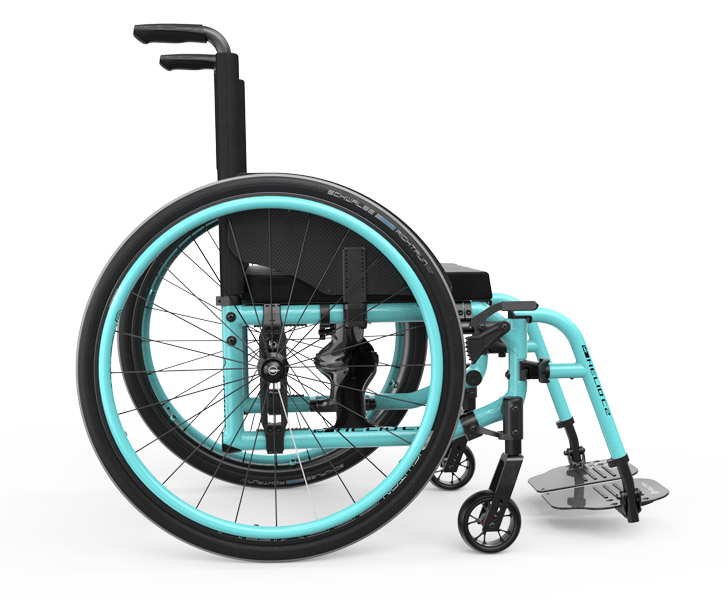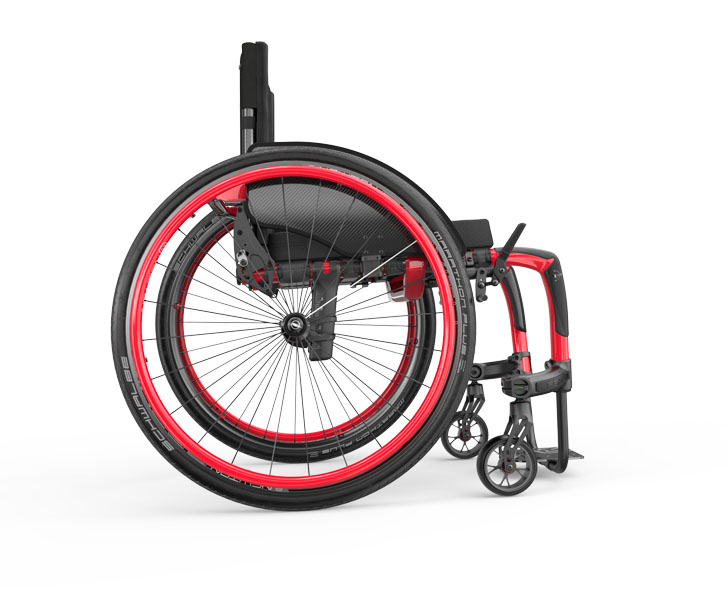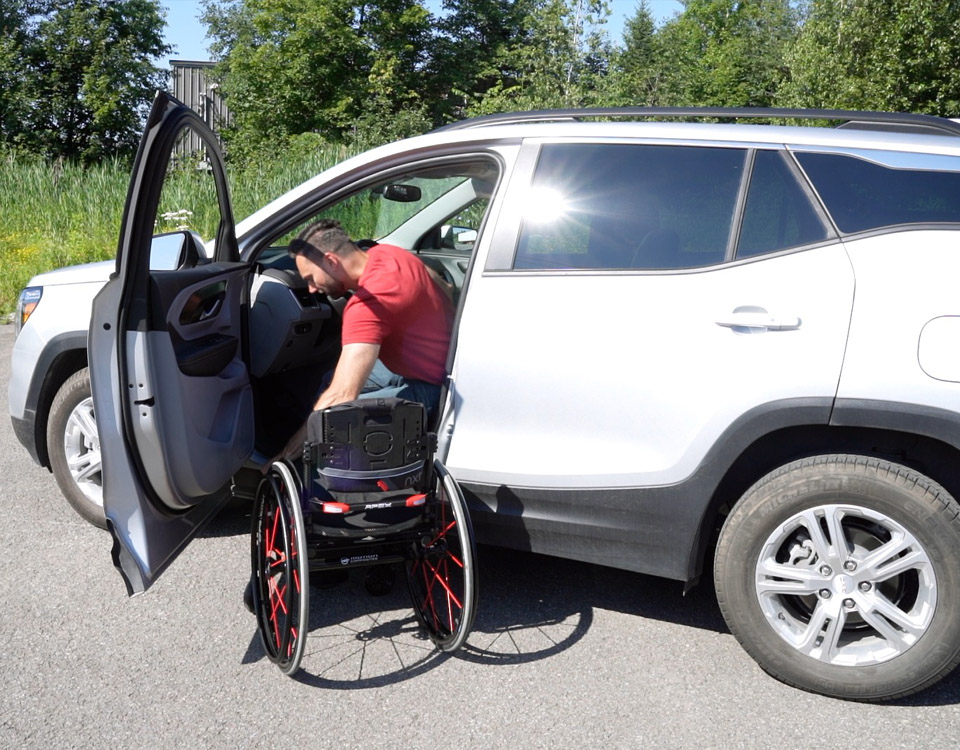Transporting Your Manual Wheelchair in and Out Of Your Vehicle
Transporting a wheelchair in and out of a vehicle is an important task that plays an essential role in your day-to-day life.
Transporting a wheelchair in and out of a vehicle is an important task that plays an essential role in your day-to-day life.
Depending on various factors, transporting a wheelchair in and out of a vehicle can be completed efficiently and safely. Or, it can be quite strenuous and repetitive, putting a wheelchair user at high risk for developing upper extremity injuries. So, is there a “right way” to transport your manual wheelchair in and out of your vehicle?
While everyone’s situation is unique, there isn’t a one-size-fits-all approach to completing this task. It’s essential to consider the wheelchair frame design, weight, and components, as well as the type of vehicle. Whether you’re a wheelchair user, caregiver, or therapist, it’s important to understand how transporting your wheelchair in and out of a vehicle can affect upper extremity health and functional independence.
For an active manual wheelchair user, the upper extremities are their power source – they are what drives their wheelchairs and enable their participation in their daily activities. That said, biomechanically, the upper extremities are not supposed to be weight-bearing joints – our lower extremities were designed to move us from point A to point B. Therefore, active manual wheelchair user needs to consider how their wheelchair use will impact them daily but also in the future. Research shows that shoulder pain in manual wheelchair users can be upwards of 70–100% and that nearly 75% of paraplegics with shoulder pain suffer from impingement syndrome (Sawatzky, et al., 2015). Knowing these statistics, we can agree that protecting the upper extremities, specifically the shoulders, is crucial. Over time, lifting a wheelchair in and out of a vehicle may also cause fatigue and possible injuries to the upper extremities. The risk for injury becomes even higher if wheelchair users and/or caregivers are not using proper body mechanics while transporting the wheelchair appropriately. A study by Requejo et al. (2015) found that the most strenuous activities for manual wheelchair users included:
Furthermore, on a self-report survey measuring shoulder pain during daily living, individuals using wheelchairs identified that the “wheelchair transfer in and out of a car” was the most problematic activity causing shoulder pain (Samuelsson et al., 2014).
When transporting manual wheelchairs in and out of vehicles, several key details can greatly improve the user's and caregiver's convenience, efficiency, and safety. For example, you may want to choose a folding wheelchair that can be easily stored in a vehicle or select a model with removable parts to make it more compact. Taking the time to carefully consider these details can significantly simplify the transportation experience for manual wheelchair users.
The design of a wheelchair’s frame can significantly impact its compatibility with different vehicles and storage options. Choosing between a folding or rigid chair will determine how and where the wheelchair can be stored more compactly, as well as whether any parts need to be removed for transportation.
A folding wheelchair is the chair of choice when considering convenience for transportation, especially for someone who may have a caregiver assisting them. By removing the rear wheels, footrest hangers, armrests, and seating components such as cushion and backrest, the wheelchair will be at its lightest weight and most compact size. This process takes time and requires additional steps and biomechanical functions to complete. When folded and with all additional components removed, a wheelchair with a folding frame becomes significantly narrower and can fit into the smaller spaces of a vehicle, such as behind the driver in the back seat, on the passenger seat, or flat in a trunk. Folding wheelchairs tend to be tall due to the presence of the back canes, and their height often limits how the wheelchair can fit through door or trunk openings. Folding wheelchairs and vehicles come in a variety of sizes and styles and therefore, may fit differently depending on compatibility.
In addition, wheelchairs with folding frames are often heavier than wheelchairs with rigid frame designs. Therefore, frequently lifting them in/out of a vehicle may be problematic. For example, a geriatric wheelchair user who has a folding frame wheelchair may be unable to lift their wheelchair in and out of their vehicle and, as a result, requires assistance from their spouse, who may have their own age-related health concerns. In this scenario, lifting a heavy wheelchair in and out of the vehicle is not the only concern. Bending down and reaching forward are movements that are required to complete the entire process and may put the caregiver at risk for injury.
 HELIO C2 Carbon Folding Wheelchair in Caribbean Blue
HELIO C2 Carbon Folding Wheelchair in Caribbean Blue
It’s a common misconception that rigid wheelchairs are not suitable for transport when in reality, they can be a great option depending on the user and their vehicle. Rigid wheelchairs often have some advantages over folding wheelchairs. Due to their design, they tend to be lighter and have a lower profile, as they feature folding back canes. Although they don’t fold in the traditional sense with a crossbrace, the dual tube or cantilever rigid wheelchairs can take up less space than a folding wheelchair. When deciding on the type of wheelchair, it’s important to find the right balance for you or your client based on specific needs, functional independence, environment, and daily activities. Considering factors like ease of transportation and storage, and the user’s level of mobility and independence, can help determine whether a rigid or folding wheelchair is the best option.

APEX C Carbon Rigid Wheelchair in Ferrari Red
Click on this link to read about how Registered Nurse Ryann Mason’s lightweight APEX C Carbon Rigid Wheelchair benefits her, especially when lifting the chair during transfers!
As manual wheelchair technology continues improving and progressing, manual wheelchair weights are currently at an all-time low. Weight not only plays an essential role in wheelchair propulsion efficiency, but it’s also something we must consider when transporting a wheelchair in and out of a vehicle. While some wheelchair users can lift their chairs themselves, others rely on caregivers for assistance. Reducing the overall mass of the wheelchair is beneficial for transporting it in and out of a vehicle (Chenier & Aissaoui, 2014). Various factors contribute to the overall weight of a wheelchair, including chair material, design, components, and accessories. It is essential to keep the weight of the wheelchair as light as possible to simplify transportation, increase efficiency, and prevent injury and fatigue. As seen in the photograph below, a wheelchair user’s mother can be seen picking up a lightweight chair with ease, placing it in the car without breaking it down, which highlights the convenience of a lighter wheelchair. Despite the variability in the weight of wheelchairs, keeping the weight to a minimum is an important factor to consider when transporting it in and out of a vehicle.
When considering how to transport a wheelchair in and out of a vehicle, it is also important to consider the compatibility of its options and accessories. It is quite common that certain components are detached and reattached for transport and therefore, choosing options and accessories that can be removed efficiently and conveniently is beneficial. These typically include rear wheels, armrests, footrests, anti-tippers, back support, and cushion. Opting for quick-release items that are durable enough to withstand frequent use, can make the process of removal and installation more efficient. Once the wheelchair is inside the vehicle, additional measures must be taken to ensure it remains secure during transit. This may involve engaging wheel locks or using unoccupied wheelchair tie-downs to prevent any potential safety hazards while the vehicle is moving.
The NXT unique One-Hand Quick Release feature allows for the back support to be easily removed from the chair and placed into the vehicle – with just one hand!
If you’re unable to place your wheelchair in a vehicle independently or with the help of a caregiver, there are other options available. Manual lifts, ramps, robotic arms, car toppers, and portable ramps are all devices that can assist with wheelchair transportation. Regardless of the method you choose, safety, ease of use, and maintenance should be top proprieties when making your initial decision.
Whether you already have your vehicle and are deciding which wheelchair to purchase, or you have your wheelchair and are deciding on a vehicle to purchase, it’s important to consider the compatibilities between your wheelchair, your vehicle, and your lifestyle. Considering the type of vehicle – whether it’s a sedan or a truck, it’s important to consider the overall height of the vehicle and how spacious it is. When comparing two-door and four-door vehicles, a two-door vehicle may be more appropriate if you require easier access, as doorways are typically wider. It’s also essential to consider where the chair will be stored in the vehicle, as this can impact loading and unloading and may determine whether you need to remove certain components, such as the wheels and armrests. Some individuals choose to place their wheelchair in the passenger seat, the back seat, or even in their trunk, depending on whether the wheelchair user can ambulate or if they have a caregiver assisting them. When storing in the trunk, it’s important to consider the type of trunk your vehicle has (hatchback vs. traditional). By considering these factors, you can decide on the best vehicle and wheelchair combination to meet your needs and maintain your independence.
Whether you’re here to gain knowledge for yourself, your loved ones, or your clients, you’re already off to a good start! According to a study, car transfers are among the most self-taught skills among wheelchair users, primarily because people don’t get a chance to perfect them while in rehab (Requejo et al., 2015). When a wheelchair user first receives their wheelchair, therapists will often educate them on basic propulsion skills, transfers within their home, and other essential skills. However, teaching clients and/or their caregivers how to transport a wheelchair in and out of a vehicle safely is crucial. By providing proper education, users will understand how to complete the transfer and transport the wheelchair in the safest manner, minimizing the risk of potential injuries and fatigue. Re-evaluating how this transfer is completed may also be necessary, as individuals’ needs change as they age and based on their diagnosis and prognosis.
By understanding the research as well as the reasons behind the recommendations for transporting a wheelchair in and out of a vehicle, we can have a significant impact on upper extremity preservation, decreasing fatigue, and promoting independence in meaningful activities. It’s important to assess the compatibility of your wheelchair with your vehicle, including transfer and storage capabilities. Experimenting with different techniques and seeking guidance from healthcare professionals to find the best method to complete a transfer and transporting the wheelchair to your vehicle is recommended. By following these tips and utilizing the appropriate equipment, you can safely and efficiently transport your wheelchair in and out of a vehicle.
Watch our Sales Representative Chris Colin demonstrate how he is loading and unloading his APEX C Carbon rigid wheelchair in and out of his car:
Note: Make sure to refer to the manufacturer’s guide to read recommended guidelines specific to your wheelchair.
